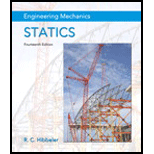
INTERNATIONAL EDITION---Engineering Mechanics: Statics, 14th edition (SI unit)
14th Edition
ISBN: 9780133918922
Author: Russell C. Hibbeler
Publisher: PEARSON
expand_more
expand_more
format_list_bulleted
Concept explainers
Textbook Question
Chapter 1.6, Problem 13P
Determine its density in SI units. Use an appropriate prefix.
Expert Solution & Answer
Want to see the full answer?
Check out a sample textbook solution
Students have asked these similar questions
my ID# 016948724. Please solve this problem step by step
My ID# 016948724 please find the forces for Fx=0: fy=0: fz=0: please help me to solve this problem step by step
My ID# 016948724 please solve the proble step by step find the forces fx=o: fy=0; fz=0; and find shear moment and the bending moment diagran please draw the diagram for the shear and bending moment
Chapter 1 Solutions
INTERNATIONAL EDITION---Engineering Mechanics: Statics, 14th edition (SI unit)
Ch. 1.6 - What is the weight in newtons of an object that...Ch. 1.6 - Represent each of the following combinations of...Ch. 1.6 - Represent each of the following combinations of...Ch. 1.6 - (b) 350 lb/ft3 to kN/m3, (c) 8 ft/h to mm/s....Ch. 1.6 - Represent each of the following as a number...Ch. 1.6 - Round off the following numbers to three...Ch. 1.6 - Represent each of the following quantities in the...Ch. 1.6 - Represent each of the following combinations of...Ch. 1.6 - Represent each of the following combinations of...Ch. 1.6 - Represent each of the following combinations of...
Ch. 1.6 - Represent each of the following with SI units...Ch. 1.6 - Evaluate each of the following to three...Ch. 1.6 - Determine its density in SI units. Use an...Ch. 1.6 - (212 mN)2, (52 800 ms)2, and [548(105)]1/2 ms.Ch. 1.6 - is a dimensionality homogeneous equation which...Ch. 1.6 - To show this, convert 1 Pa = 1 N/m2 to lb/ft2....Ch. 1.6 - What is the density expressed in SI units? Express...Ch. 1.6 - Evaluate each of the following to three...Ch. 1.6 - If the density (mass/Volume) of concrete is 2.45...Ch. 1.6 - If the man is on the moon, where the acceleration...Ch. 1.6 - If they are 800 mm apart, determine the force of...
Additional Engineering Textbook Solutions
Find more solutions based on key concepts
10.5" Balance the angles in Problem 9.22 El. Compute the preliminary azimuths for each
course.
Elementary Surveying: An Introduction To Geomatics (15th Edition)
The 60 mm-diameter steel shaft is subjected to the torques shown. Determine the angle of twist of end A with re...
Mechanics of Materials (10th Edition)
Star Pattern Write a program that displays the following pattern:
Starting Out with Java: From Control Structures through Data Structures (4th Edition) (What's New in Computer Science)
Given that y = ax3 + 7, which of the following are correct Java statements for this equation? 1. int y = a x ...
Java How to Program, Early Objects (11th Edition) (Deitel: How to Program)
In what year was Plankalkl designed? In what year was that design published?
Concepts Of Programming Languages
Also, what is the magnitude of the resultant force? Probs. 2-11/12
INTERNATIONAL EDITION---Engineering Mechanics: Statics, 14th edition (SI unit)
Knowledge Booster
Learn more about
Need a deep-dive on the concept behind this application? Look no further. Learn more about this topic, mechanical-engineering and related others by exploring similar questions and additional content below.Similar questions
- My ID#016948724 please solve this problems and show me every step clear to follow pleasearrow_forwardMy ID# 016948724arrow_forwardPlease do not use any AI tools to solve this question. I need a fully manual, step-by-step solution with clear explanations, as if it were done by a human tutor. No AI-generated responses, please.arrow_forward
- Please do not use any AI tools to solve this question. I need a fully manual, step-by-step solution with clear explanations, as if it were done by a human tutor. No AI-generated responses, please.arrow_forwardPlease do not use any AI tools to solve this question. I need a fully manual, step-by-step solution with clear explanations, as if it were done by a human tutor. No AI-generated responses, please.arrow_forward[Q2]: The cost information supplied by the cost accountant is as follows:Sales 20,00 units, $ 10 per unitCalculate the (a/ newsale guantity and (b) new selling price to earn the sameVariable cost $ 6 per unit, Fixed Cost $ 30,000, Profit $ 50,000profit ifi) Variable cost increases by $ 2 per unitil) Fixed cost increase by $ 10,000Ili) Variable cost increase by $ 1 per unit and fixed cost reduces by $ 10,000arrow_forward
- can you please help me perform Visual Inspection and Fractography of the attatched image: Preliminary examination to identify the fracture origin, suspected fatigue striation, and corrosion evidences.arrow_forwardcan you please help[ me conduct Causal Analysis (FTA) on the scenario attatched: FTA diagram which is a fault tree analysis diagram will be used to gain an overview of the entire path of failure from root cause to the top event (i.e., the swing’s detachment) and to identify interactions between misuse, material decay and inspection errors.arrow_forwardhi can you please help me in finding the stress intensity factor using a k-calcluator for the scenario attathced in the images.arrow_forward
arrow_back_ios
SEE MORE QUESTIONS
arrow_forward_ios
Recommended textbooks for you
 International Edition---engineering Mechanics: St...Mechanical EngineeringISBN:9781305501607Author:Andrew Pytel And Jaan KiusalaasPublisher:CENGAGE L
International Edition---engineering Mechanics: St...Mechanical EngineeringISBN:9781305501607Author:Andrew Pytel And Jaan KiusalaasPublisher:CENGAGE L

International Edition---engineering Mechanics: St...
Mechanical Engineering
ISBN:9781305501607
Author:Andrew Pytel And Jaan Kiusalaas
Publisher:CENGAGE L
Understanding Thermal Radiation; Author: The Efficient Engineer;https://www.youtube.com/watch?v=FDmYCI_xYlA;License: Standard youtube license